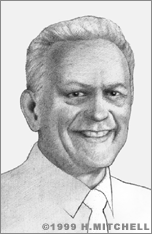Amar Bose
Amar Bose used his instincts and education to produce stereo speakers that are world-famous for giving high-end performance despite their modest size.
Bose was born on November 2, 1929 in Philadelphia. He was the son of a political dissident who had immigrated from Calcutta, India. Young Bose first became interested in technology at age thirteen when he started repairing model trains in order to supplement his family’s income. Later, Bose moved on to repairing transistors.
Bose entered the Massachusetts Institute of Technology (MIT) with a great deal of practical experience in electronics. After he graduated with a BS in Electrical Engineering in the early 1950s, Bose embarked on a personal crusade to invent a stereo loudspeaker that would reproduce, in a domestic setting, the vivid sound that a member of the audience hears at a great concert hall. Bose’s early patents won him great respect within the industry, but he needed capital in order to do further research and begin production. In time, Bose received financial support from MIT professor Y. W. Lee (who bet his life savings on the effort) and founded Bose Corporation in 1964.
As a student at MIT, Bose had learned that 80% of the sound heard by a person in a concert hall is indirect (i.e., bounced off the ceiling and walls) rather than direct from stage to ear. In 1968, Bose capitalized on this notion by inventing the 901(R) Direct/Reflecting(R) speaker system: one of the first stereo loudspeakers to utilize the space around them instead of reproducing sound as if in a vacuum.

Bose’s 901(R) speakers remained an industry standard for 25 years. In the meanwhile, Bose developed the Auditioner(R) audio demonstrator, which takes the specifications of a given room, hall, or other space and demonstrates precisely how a given Bose speaker system will sound in that space – even before it is built. Bose’s sense of spatial acoustics also helped him to conquer the car stereo market with systems that transformed the on-the-road listening experience. Here, as always, Bose proved that full, rich sound does not require big, bulky speakers. In fact, his products are famous for their simple and elegant design.
Amar Bose earned over two dozen patents, and his products can be found in Olympics stadiums, Broadway theatres, the Sistine Chapel, and the Space Shuttle, where his noise cancellation system protects the astronauts from permanent hearing damage.
Bose also taught electrical engineering and computer science at MIT until 2001.
In 2004, he unveiled Bose’s suspension system in cars after 24 years of research and development.
Bose died on July 12, 2013 at the age of 83.


